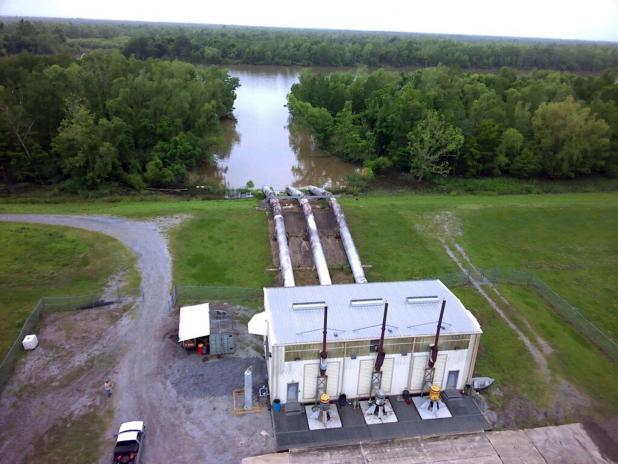
During heavy rain or when the Atchafalaya is rising, local systems bring water to pump stations operated by the Wax Lake East Drainage District.
Submitted Photo
Drainage district, local systems join forces in flood fight
EDITOR’S NOTE: This column was submitted to The Daily Review by the superintendent of the Wax Lake East Drainage District.
Our area communities experience their share of storms and hurricanes, some of which drop more rain than others.
You may wonder: What keeps the water out of your homes and businesses?
The answer is not simple.
In east St. Mary Parish, we live in bowls surrounded by levees that protect us from riverine floods and storm surges flowing around us through the Atchafalaya River, the Wax Lake Outlet, the Intracoastal Waterway and other waterways leading to the Gulf of Mexico and from the Atchafalaya Basin.
This flood and storm surge protection brings about a potentially bigger concern of heavy rain events over the Wax Lake East Drainage District area.
These heavy rains, if not pumped out of the bowl, could flood many streets, roads, homes and commercial properties. Without proper storm water drainage systems, most roads in the district could become impassable.
We just can’t pull a drain plug. As with a large boat, the water must be pumped out.
In an effort to protect property from flood events on the Mississippi River and its tributaries (i.e., the Atchafalaya River), the U.S. government tasked the U.S. Army Corps of Engineers to design and construct riverine flood protection systems throughout south Louisiana.
As a result, the Corps designed and constructed levees, flood gate structures, flood walls and storm water pump stations.
In order to obtain the dirt needed for these projects, the system created borrow canals adjacent to and on the protected side of the levees. We use the term “bar” pit or “borrow” pit when referring to these water-filled areas.
The work started in the 1940s. The flood walls in Berwick and Morgan City were built in lieu of levees, but tie into the levee system on the northern and southern end of the flood walls.
In 1965, the St. Mary Police Jury created the Wax Lake East Drainage District, the boundaries of which encompass the town of Berwick, the community of Bayou Vista, the city of Patterson and the Calumet area.
Its boundary limits are the West Atchafalaya Basin Levee on the north, the Wax Lake East levee on the south (along the Intracoastal Waterway), the Berwick flood wall on the east and the Wax Lake Outlet East Levee on the west.
The district is operated and governed by a Board of Commissioners appointed by the St. Mary Parish Council, and its operations and maintenance are funded by a voter-approved ad valorem tax.
The Board of Commissioners is charged with using these funds to provide storm water drainage through the construction, maintenance and operations of a system of drainage ditches, drainage canals, natural bayous and borrow canals to move storm water from developed areas and agricultural areas to its pump stations.
The pump stations pump the water out of the bowl over the levees.
The pump types and sizes vary by location and fuel source, including natural gas, diesel and electric.
Drainage district personnel must keep the whole system operational through ongoing maintenance and repairs.
Storm water from the communities within the district flows through ditches and canals under the railroad tracks, continuing to the southernmost borrow canals, where the major pumps are located.
The internal drainage systems along the streets and roads of the communities of Berwick, Patterson and Bayou Vista must be maintained by their governing authorities. The internal systems play an important role in moving the storm water from the streets and neighborhoods to the drainage district’s system of ditches and canals.
Each one of these entities is responsible for addressing the maintenance of their respective internal drainage systems. Being proactive will serve us well.
The Wax Lake East Drainage District is charged with pumping out every drop of rain that falls into its bowl. The huge, fuel-hungry pumps receive the storm water and pump it out of the system. During the last few rain events, several billions of gallons of water were pumped out of the bowl.
In an effort to continue to improve its ability to provide storm water drainage to its citizens, the Wax Lake East Drainage District is constructing an additional pump station and, in cooperation with several pipeline companies, is making improvements to the ditches and canals that flow over or under several pipelines.
The district is also negotiating with BNSF Railroad to create larger openings under the railroad trestles, which can allow for repairing and widening the ditches, canals and bayous that pass under the tracks.
The drainage work will improve the flow of storm water to the pumps. It is anticipated that the town of Berwick will benefit most from this endeavor.
It is imperative that each community within the district have trained personnel, equipment and a well-maintained internal drainage system to best serve its citizens. There is a cost, but we have little choice but to properly fund the drainage within our communities to protect property values, insurance rates and business development.
The communities from the Atchafalaya River to the Wax Lake Outlet have unique challenges but are ready, willing and able to eliminate them.
